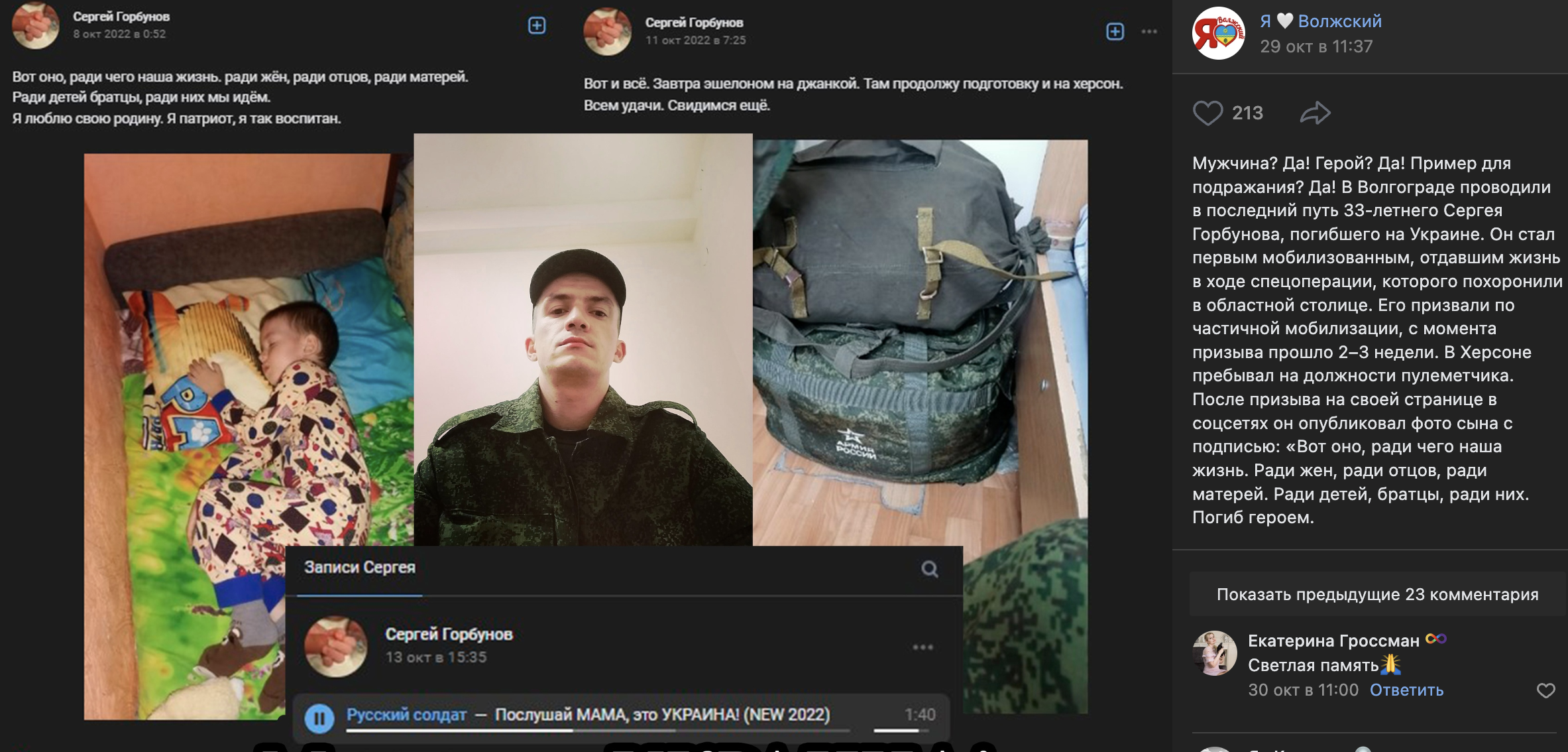As The Insider has learned, the missile attack on Makiivka, where between 60 (according to Russian data) and 600 (according to Ukrainian data) Russian soldiers died, was not the only strike that caused mass deaths of mobilized Russian soldiers. Analyzing the dates of the death of Russian conscripts, The Insider found that on October 24, in the area of Nova Kakhovka (Kherson region), at least several dozen mobilized people became victims of a similar strike. Especially many of the dead were from the Volgograd region – it was in the Volgograd forums that they drew attention to a strange anomaly: starting from the end of October, local newspapers began to publish two or three obituaries about mobilized soldiers, and under all the photographs there was the same date of death – October 24 2022.
The place and circumstances of death were not reported in the obituaries.

The media published the names of 20 mobilized from Volgograd and the region – all died that day in the Kherson region near Nova Kakhovka (Kherson region was confirmed for two more, but without specifying the location). How many people died from this strike is not clear, but the number could be much higher, since these names are what could only be found in Volgograd obituaries.
Those who died in Novaya Kakhovka, who are known:
- Alekseev Sergey
- Gorbunov Sergey Vyacheslavovich
- Guzev Alexander
- Zabaluev Alexander Vasilievich
- Kopanev Alexey Dmitrievich
- Kuzmin Alexander Nikolaevich
- Makarovsky Evgeny
- Martynenko Sergey
- Mikhalev Alexey
- Orlov Evgeny
- Saratovtsev Mikhail Nikolaevich
- Smirnov Gennady
- Tarbushin Gennady
- Tevyanov Alexander
- Tomarev Alexander
- Shmelev Sergey Rafigovich
- Kostryukov Evgeniy
- Lysenko Konstantin
- Poklonsky Nikita
- Sysoev Dmitry
- Arslanbekov Ilnur Ildarovich (born in the Tyumen region, died in the Kherson region)
- Makhmatov (Makhmadov) Ilkhom Ermakhmatovich (born in the Vologda region, died in the Kherson region)
There is no official data on the reasons for the death of these soldiers, but on November 3, information appeared in several VKontakte public pages that on October 24, a convoy of Volgograd mobilized soldiers sent to the front was fired on in Ukraine. The publications attached a list of 20 names, all matching those listed in media obituaries. On November 11, a post with the list was published by the rector of the church of St. Admiral Theodore Ushakov, secretary of the Disciplinary Commission of the Volgograd diocese, deputy head of the prison ministry Evgeny Karavaev. He also pointed out that the place of death of the mobilized is New Kakhovka.
The ROMB YouTube project was able to contact a relative of one of the victims, who confirmed that Volgograd residents came under fire in a column near the Kakhovskaya hydroelectric power station.
“On the 27th, we went to the military registration and enlistment office, we were told that the whole car had died – 20 boys. Where they were going, they can't tell us. They began to leave for the Kakhovskaya hydroelectric power station. Several cars, 90 people, and the very first car came under fire. What exactly happened there – no one told us anything. Fragments – presumably HIMARS.
The mother of one of the victims said that the military registration and enlistment office did not give her any information at all, saying only: “Sorry, it happened.” The journalists also managed to contact the mobilized man, who, allegedly, was in that convoy, but survived. He said that people were packed into KamAZ trucks, they were sitting on the sides, the cars were moving at a speed of 35-40 km / h and constantly stopped, so one blow was enough to kill 20 people at once.
The journalists of the local information portal V1.ru tried to find out the circumstances of the death of the mobilized Volgograd residents. However, no one gave them any details. The simultaneous death of two dozen Volgograd residents was ignored by the authorities, writes the media.
“From the men whom the Motherland called for help, the authorities of Volgograd and the region seemed to disown. There are no words of condolence either on the official websites of the governor and the administration of the Volgograd region, or on the website of the administration of Volgograd, or on the websites of the Volgograd city and Volgograd regional dumas. Public and entertainment events have not been cancelled. There will also be a rally with a religious procession on November 4.”
Neither the local administration nor the Duma answered the journalists' questions. No responses were received to inquiries. Volgograd City Duma Chairman Vladlen Kolesnikov did not answer numerous calls from correspondents. The chairman of the city council of veterans, Alexander Strukov, said that he knew “what happened there,” but advised him to contact “the military registration and enlistment office” for details.
Apparently, rocket strikes against military convoys, leading to the simultaneous death of dozens of people, are a much more frequent occurrence than is known from the media. According to analysts of the Dutch project Oryx, from February 24, 2022 to February 2, 2023 (at the time of writing), the Ukrainian military managed to destroy:
- 662 KAMAZ 6×6;
- 592 Ural-4320;
- 16 KAMAZ 8×8:
- 20 KAMAZ 4×4;
- 31 KAMAZ with an armored cab.
As The Insider was told in the Armed Forces of Ukraine, only on October 24, and only in the Kherson region, Ukrainian troops attacked a military concentration in Zabarino (according to the estimates of the Armed Forces of Ukraine – about 70 dead), in Aleshki – two covering the accumulations, as well as an attack on a supply convoy of five trucks moving along the R-57 highway (preliminarily seven dead). At the same time, a blow was struck at the base of the Russian military in the village of Cairo, Kherson region, it was located on the territory of the local lyceum, the number of victims is unknown.


